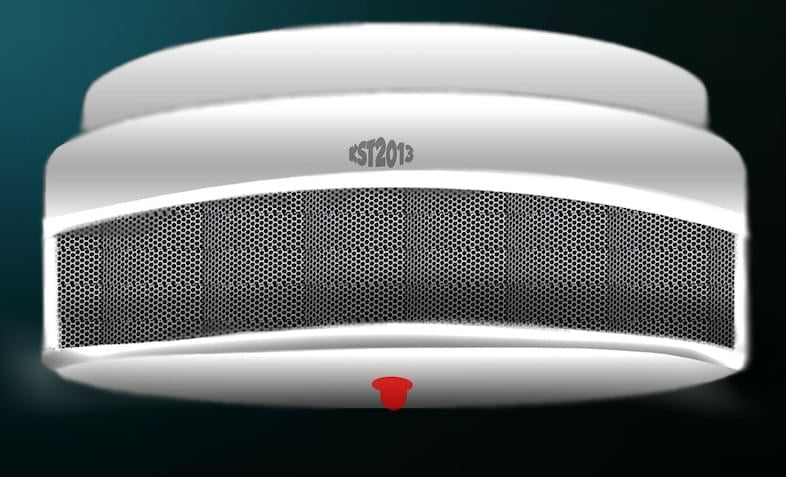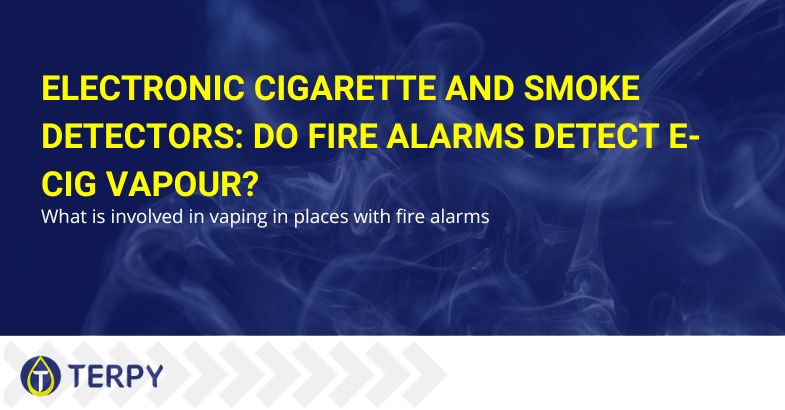Modified on: 27/05/2024
What is involved in vaping in places with fire alarms
Do you enjoy vaping your e-cigarette everywhere and can’t part with it even when you are indoors? If so, you probably want to know whether the vapour of your vaping liquids can trigger the alarm in places where smoke detectors are installed. Well, steam has a very different composition to smoke. Nevertheless, depending on the type of smoke detector, even vaping your e-cig could trigger the alarm mechanism.
In this Terpy blog article, you will find out how the three most commonly used smoke detection systems are activated and how you should vape (if allowed) in environments where such devices are present.


When the smoke detector is activated and how the various devices react to e-cigarette vapour
Smoke detectors may be present in public places as well as in homes. In many cases, installing these safety devices is required by law; however, there are different types of alarms, and not all activate in the same way. As an avid vaper (or enthusiast) of tobacco or fruity liquids, you probably want to know if the vapour produced by your e-cig can trigger smoke detectors. Let’s look at how the most popular models work and find out what effects a vape in the vicinity of one can have.
We begin with photoelectric detectors, which give an alarm signal when the light radiating from the transmitter to the receiver is interrupted by smoke. This type of detector, by nature, does not distinguish smoke from vapour; therefore, vaping in an environment where such a system is installed could cause an alarm, especially in the presence of a very dense vapour cloud.
Another widely used system is the optical system, which resembles the photoelectric system in many respects. These detectors also have a transmitter and a receiver between which a beam of light passes. However, such devices detect smoke as it is composed of solid particles that reflect light, a characteristic that vapour does not possess. However, since the fumes of the electronic cigarette contain microparticles, the most sensitive detectors could be triggered if a substantial vapour cloud intercepts the light beam.
The most accurate and modern equipment is undoubtedly ionisation equipment. How do they work? These devices comprise two electrical plates, separated by a small amount of radioactive material, between which current passes. The ionisation of the small environment within the system is interrupted by smoke particles, and the drop in current triggers the alarm. Although it has happened in some cases that the vapour from an electronic cigarette activates this type of device, it is a relatively rare occurrence.
Read also: Beginner’s guide to temperature control in the electronic cigarette
Vaping indoors? Here’s how to circumvent smoke sensors
As we mentioned in the previous section, there is a severe possibility that two of the three most common types of smoke detectors will be triggered by vaping. But are there any good practices to prevent this from happening? Of course, there are. First, however, it should be pointed out that before vaping your e-cig in an enclosed environment, it would be a good idea to make sure that vaping is not prohibited, to ask if there are any fire detectors and, if so, where they are installed.
The last point is very important because, as you well know, vapour can be thicker than smoke but tends to dissipate quickly. Consequently, a cloud of vapour blown in the vicinity of devices can have quite different effects from one expelled some distance away. Therefore, to avoid causing false alarms, it is advisable firstly to vape at a safe distance from the detectors; secondly, you would do well to open a window to ventilate the room you are in and accelerate the dissolution of the vapour produced by vaping. Furthermore, using an e-liquid base with a high percentage of PG (propylene glycol) also reduces the risks as the element that generates a thick and consistent vapour is VG (vegetable glycerol).


Vaping in hotels: Is it possible to smoke an e-cig in the room?
Let’s face it: the fact that the e-cig produces vapour and not smoke does not mean you can vape anywhere. In most closed environments, out of respect for other people and to avoid unpleasant incidents and penalties, it is essential to ask if vaping is allowed. The hotel is one of the most classic examples, not least because – in many cases – the installation of fire protection systems is mandatory in this type of establishment. Each hotel has its policy regarding the possibility of vaping inside and in the rooms.
Therefore, as there is no fixed rule, should you stay in a hotel (even abroad), we advise you not to use an electronic cigarette in your room without first making sure (or ascertaining) that the management allows this practice.
In conclusion
In this article, we have outlined the effects of e-cigarette vapour on the most common smoke detectors and given you tips on how to avoid setting off alarms inappropriately and the risk of fines and penalties (as well as embarrassment).
Suppose you would like to buy electronic cigarette liquids whose vapour is not too thick. In that case, you will find a variety of base liquids, unique flavourings and everything you need for safe, quality vaping at Terpy.





